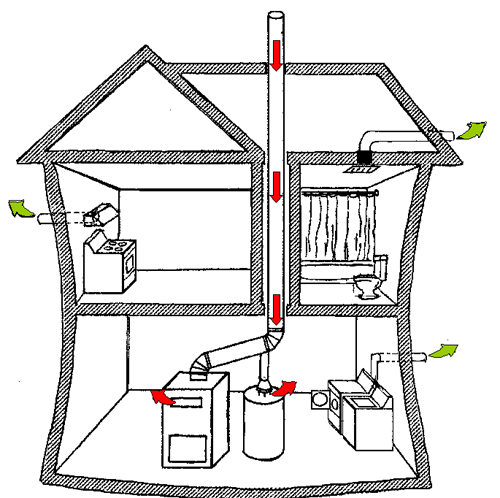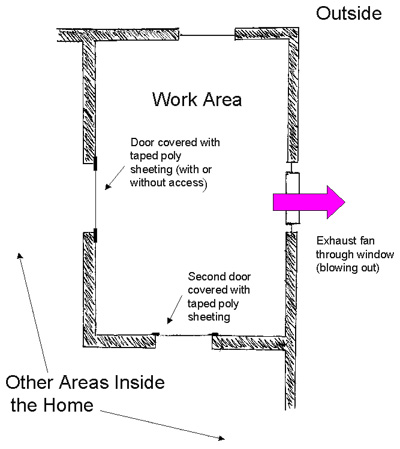Best Practices for Indoor Air Quality when Remodeling Your Home
On this page:
- Good Work Practices
- Use Barriers to Contain Dust & Pollutants
- Combustion Appliance Backdrafting
- Use Ventilation to Contain Dust & Pollutants
Good Work Practices
Regardless of what part of the house your remodeling project takes place in, there are good work practices that you can use to help minimize or prevent indoor air and other indoor environmental problems.
These practices include the following:
- Correct the underlying cause of any problem. For example, if you are repairing a damaged paint surface, look to see what might have caused the damage, e.g., moisture from the inside (such as condensation), or from the outside (as with roof leaks), rubbing or impact of painted surfaces, or structural damage.
- Assume Paint in Homes Built Before 1978 Contains Lead. Unless a lead-based paint inspection shows otherwise, you should treat paint in homes built before 1978 as if contains lead. Exposing anyone to lead dust, especially children, is harmful.
- See further information on lead if this applies to your home.
- Do Not Disturb Asbestos. If a project requires disturbing areas that contain asbestos, use an asbestos professional or contact your health department for advice before proceeding.
- For more information about asbestos, including how to protect those in your home during a remodeling project, visit EPA's Asbestos: Protect Your Family website.
- Avoid Exposure to Mold or Bacteria. Basic Mold Cleanup
Potential health effects and symptoms associated with mold exposure include allergic reactions, asthma and other respiratory complaints. The key to mold control is moisture control. It is important to dry damaged areas and items within 24-48 hours to prevent mold growth. If mold is a problem in your home:- Clean up the mold and get rid of the excess water or moisture.
- Fix leaky plumbing or other sources of water.
- Wash mold off hard surfaces with detergent and water, and dry completely.
- Absorbent materials (such as ceiling tiles and carpet) that become moldy may have to be replaced.
- If a project is likely to expose large areas of microbial growth, consult with an environmental professional about adequate protective measures.
- More information is available on EPA's mold page - EPA's Mold website
- Avoid Creating Dust (and Contain Dust That Can't Be Avoided). Many remodeling activities, from demolition to removing wood casings, have the potential to create dust. Use low-dust work practices (for example, mist surfaces with water before sanding or scraping). Cover the area under work with a durable protective sheeting (e.g., a plastic or poly tarp).
- Use barriers to keep dust contained to immediate work area. (See also ventilation strategies discussed below.)
- Provide Ventilation. Exhaust ventilation (e.g., a fan blowing out) from the work area will help remove dust and other pollutants AND, by creating a pressure barrier, will help keep pollutants from spreading to other parts of the house. After applying paints or finishes, installing flooring (such as carpeting), or other activities likely to "off-gas" pollutants, continue to provide maximum ventilation to the space. The typical recommendation is to provide maximum ventilation both during installation and for at least 72 hours after installation is completed.
- Read more about pressure barriers
- Protect Occupants from Exposure to Odors and Pollutants. Keep occupants, especially children, away from the work area. Clean up the work site before they return. (Workers should wear proper protection, keep clean and avoid taking dust home with them!) Use barriers (e.g., taped plastic sheeting over doors and other openings) and local exhaust ventilation to prevent pollutants from spreading through the home. When possible, allow materials containing VOCs to off-gas outside before bringing them into the home. Likewise, when possible, apply finishes such as paint and sealers to building materials outside, and bring them into the home after they are dry.
- Read more about Volatile Organic Compounds
- Use Appropriate Storage and Disposal Practices for Paints, Solvents, Clean-up Materials and Asbestos-Containing Materials. Seal containers carefully after use. Keep paint containers in storage areas, preferably equipped with exhaust ventilation, but not near heating, ventilation, or air-conditioning equipment rooms. Use an appropriate waste disposal method to dispose of any paints containing lead or mercury. Follow appropriate regulations for disposal of asbestos-containing materials.
- Follow Manufacturers' Instructions. As a minimum, follow the manufacturers' recommendations regarding proper use, ventilation requirements, and other health and safety guidelines for all products and materials, including paints, sealants, adhesives, and appliances.
Material Safety Data Sheets (MSDS) — which are intended to provide both workers and emergency personnel with the proper procedures for handling or working with a variety of substances — are available from manufacturers. A typical MSDS includes information such as:- toxicity
- health effects
- first aid
- reactivity
- storage
- disposal
- protective equipment
- spill/leak procedures
These are of particular use if a spill or other accident occurs. A MSDS is also a possible starting point for evaluating a manufacturer's health and safety claims. To learn more, search the internet on the term "MSDS".
Using Barriers to Contain Dust and Other Pollutants
Barriers should be used to contain the spread of dust and other pollutants from the work area to other parts of the home. A simple barrier consists of 6 mil poly sheeting taped over doors and other openings in the room. Poly sheeting should also be taped over any supply and return registers for the home's heating, cooling, or ventilation system which are in the room to avoid spreading the pollutants or contaminating the ducts. Having blocked off registers, you should be sure to provide ventilation for the area. An exhaust fan, with provision for make-up air, complements this strategy well. For more information, see the discussion of ventilation containment strategies which create a pressure barrier to prevent the spread of pollutants.
The following description, from HUD's Lead Paint Safety: A Field Guide for Painting, Home Maintenance and Renovation Work) illustrates how a barrier can be created which still allows access into the room. Note that for high dust jobs, or when generating other pollutants such as paint fumes, you may want to seal the room off completely from the rest of the house (without access from the inside).
- U.S. Department of Housing and Urban Development's Office of Healthy Homes and Lead Hazard Control - HUD
Containing Dust:
Use this system to keep dust from spreading to another room.
- Fold protective sheeting at top and bottom before taping into leave slack.
- Duct tape protective sheeting to perimeter of opening. Leave slack at the top and bottom. Stable corner for reinforcement.
- Cut slit in protective sheeting to within 6" of top and bottom. Duct tap[e may be used for reinforcement.
- Then tape another sheet of protective sheeting to top of door. Cut just short of floor. Staple top corners.
If a job creates extremely high amounts of dust (for example, demolition) or large amounts of dust in the air for more than short periods, the protective flap system shown above my not be sufficient to prevent dust from spreading beyond the work area.
For these types of jobs, a more protective system called "isolation" is needed so that dust does not spread beyond the work area. Isolation means that the work area is sealed with no direct access to occupied areas of the home. Workers need to use an entrance that is separated from occupants until cleanup is completed."
Combustion Appliance Backdrafting
As we exhaust air from our homes, and as air naturally leaks out of our homes because of wind or the stack effect, it is replaced by outdoor air. If we exhaust a lot of air, we can depressurize the home. Sufficient depressurization can actually pull air and combustion products back down a chimney or any flue, such as that of a gas water heater, and into the house. Because of the harmful substances, such as carbon monoxide, in combustion gases, this depressurization can create a very dangerous situation.
Forces working to depressurize a home include those shown in the figure below, bathroom exhaust fans, kitchen range hoods and clothes dryers. Other forces not shown in the diagram include:
- Fireplaces
- Leaky return ducts near combustion equipment
- Leaky supply ducts outside the conditioned space
- Wind
- The stack effect (warm air rising in a building tends to depressurize lower areas)
If these forces are great enough, they can work to suck air and combustion products back down the chimney or flue and into the house, as shown by the red arrows in the diagram.

- There are steps you can take to prevent backdrafting. Read more about combustion appliances.
Using Ventilation to Contain Dust and Other Pollutants
Note: The practices on this page are not approved for removing or disturbing lead-based paint, which requires special procedures to protect occupants, workers, and the environment. If you live in a home built before 1978, you may have lead paint. EPA requires individuals and firms who perform renovation, repair, painting or other projects that disturb paint in pre-1978 target housing and child-occupied facilities to be certified and follow specific work practices.
- Current information on working safely with lead-based paint, getting lead-safe certified, or checking to see if your contractor is certified
- Current information on evaluating and eliminating lead-based paint hazards
Ventilation is an important part of maintaining indoor air quality during a renovation project, including keeping any dust or other pollutants out of the general area of the home. One effective strategy is to use exhaust ventilation — as simple as a box fan blowing from the work area directly out of the house. This does two things. First, it immediately removes much of the pollutants from the home. And second, it creates a pressure barrier which effectively prevents air — and pollutants in the air — from moving from the work area to the rest of the house.
If using a box fan in a window, secure the fan within the window frame so that it cannot fall out of the window or be tipped over by children. If it rains or snows, turn the fan off and remove it from the window to avoid any electrical shock hazard.
To increase the effectiveness of the pressure barrier, physical barriers can be used.
The following illustration shows the basic approach.

